Where Is Side Ancient City? Discover the History of Pamphylia’s Most Important Port
The ancient city of Side is one of the most remarkable historical sites in the historical region of Pamphylia. It is also one of the most significant central locations of this period in the region. This important historical structure, where archaeological research is still ongoing, continues to attract tourists from all over the world. So, where is Side, the most important port city of Pamphylia in ancient times? What is the history and legend of the Ancient City of Side?
Here are the places to visit in the Ancient City of Side 👇
Ancient Language Spoken in the Ancient City of Side!
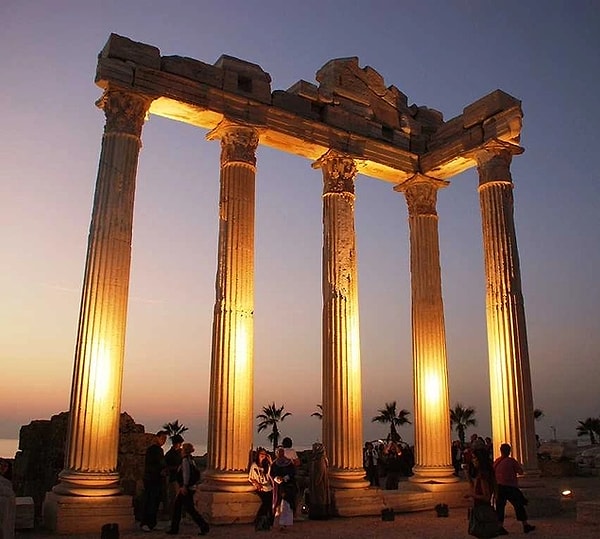
The ancient city of Side, which dates back to antiquity and was ruled by many emperors, is one of the most important places in the region. In the past, the inhabitants of this area spoke a language known as 'Sidece'. Although the origin of this language is still unknown, it is believed to be of Luwian origin. Sicilian is recognised as one of the Indo-European languages.
Source: Kültür Portalı
History of the Ancient City of Side
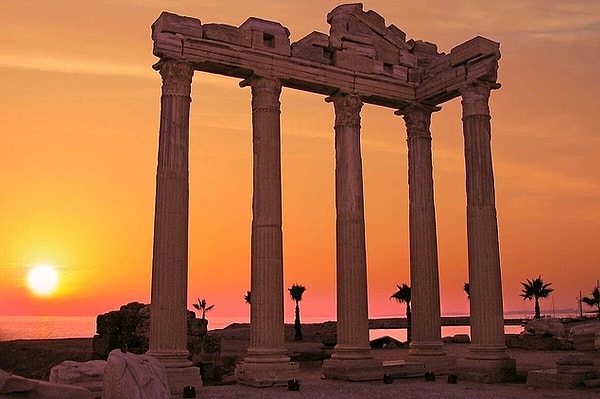
The word Side means 'Pomegranate' in Anatolian languages and therefore the symbol of the city has become pomegranate. It is understood from the inscriptions that the history of Side dates back to the Hittites and that a unique Indo-European language called 'Sidece' was spoken until the 3rd century BC. It is rumored that the city got its name from a legend about the pomegranate tree.
Ancient Side was one of the five important cities of the Pamphylia region and served as a natural harbor. It was the only harbor in the region until Antalya was founded. The city, which dates back to the 2nd century A.D., is located 75 km east of Antalya, southwest of Manavgat, on a peninsula 1,000 m long and 400 m wide.
Although the first settlement is thought to have started with Greek colonies in the 7th century BC, the fact that the word 'Side' is not Greek indicates that there was a settlement before. The city was ruled by Lydians, Persians, Alexander the Great, Ptolemies, Pergamon Kingdom, Romans, Seljuks and Anatolian principalities respectively.
Side, which lived its heyday as a trade center in the 2-3rd century A.D., became the episcopal center of Pamphylia in the 5th century. Destroyed in the 7th century by Arab raids, the city was revived in the 13th century during the Seljuk period, and immigrants from Crete settled in the region in 1895.
The theater in the city is the largest theater in Pamphylia built on columns and has a capacity of 17,500 people.
Besides the baths and theatre, other ruins in the city include:
Roman Aqueducts
Libraries
2 Unique Temples
Ancient Harbour
Agora Collonaded Street and City Walls.
Where is the Ancient City of Side?
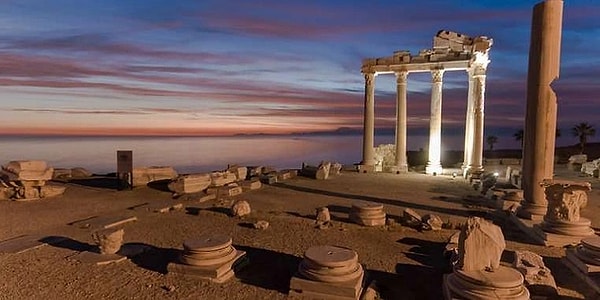
The Ancient City of Side is located in the Mediterranean region of the Manavgat district of Antalya. It is regarded as one of the important defence centres of the region with its magnificent view.
By car, you can reach the unique Ancient City of Side from Antalya to Manavgat city, which has been under the rule of various rulers throughout history.
Visiting Hours of the Ancient City of Side

The ancient city of Side can be visited at varying times during summer and winter. In summer, it can be visited from 08:00 in the morning until 7:00 p.m. During the winter season, visiting hours are from 08:00 in the morning until 7:00 p.m.
The Legend of the Ancient City of Side
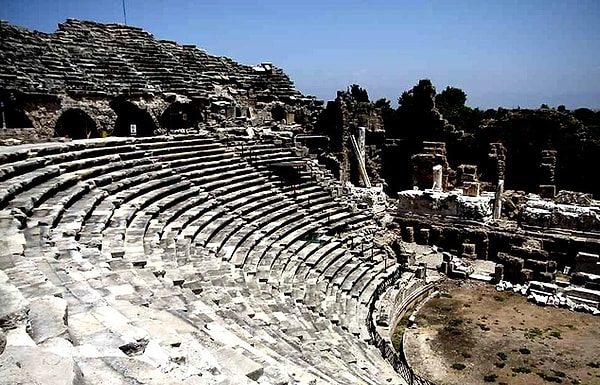
The “Pomegranate” is recognised as the symbol of ancient goddesses representing the region in Anatolia. In this respect, the ancient city of Side, boasting various temples, is also recognised as an important place of worship. It also possesses a unique language that has yet to be fully deciphered. This language is known as “sidece”.
The story of Side, the goddess who transformed into a pomegranate tree, according to legend, Side is the daughter of the Anatolian mountain god Taurus (Toros), known as the goddess of nature and fertility. One day, the goddess is walking along the banks of the Melas (Manavgat) river with her daughter and the forest nymphs (fairies). In this magical place, where they sing and dance, the goddess Side gently plucks a branch from a tree adorned with flowers she cannot resist. Suddenly, blood drips from the tree, startling her and filling her with sorrow. In that moment of despair, she discovers that her feet are rooted in the ground as she attempts to flee. There, she can never move again; her trunk transforms into a tree with bark. Side realises that the tree from which she broke a branch is, in fact, a goddess who has turned herself into a tree to protect against evil. Unable to hold back her tears, she says, “From now on, I will be a tree that bears fruit the colour of blood. Bring my daughter to me often, and let her play in my shade. But tell her not to pluck flowers and damage trees again.”
Side Ancient Theatre

Side Ancient Theatre was constructed in the tradition of Roman architecture in the heart of the ancient city of Side. The section leading up to the road in the middle of the steps in the seating rows of the theatre leans against a slope. The upper part of the seating steps was designed to be inclined upon the vaults and constructed following the plane. Thanks to this feature, Side Ancient Theatre is the only example of such architecture in Anatolia. This building, which boasts a three-storey stage, draws attention with its Antonine Period baroque decorations. The Side Ancient Theatre shares common architectural traits with the Colosseum. Documentation indicates that the theatre, with a seating capacity of 17,000, was used for gladiatorial and animal fights during the Late Roman Period. Entrance to the theatre is free, and the Museum card is valid.
Source: Antalyagezirehberi.net
Side Ancient City Apollo - Athena Temple
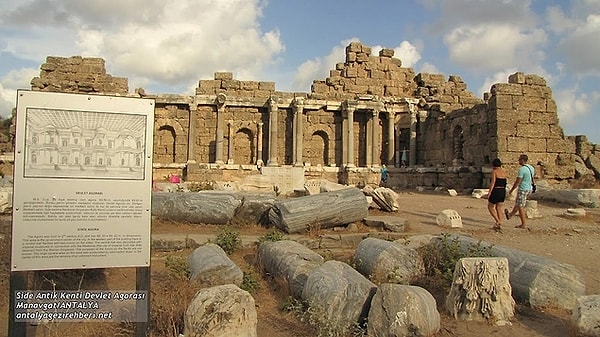
The Side Apollo and Athena Temples, with their remarkable stance and their position reaching towards the sun-sky, along with their admirable history, now attract the attention of people from diverse cultural backgrounds.
History of the Temples of Apollo and Athena
The inhabitants of the ancient city of Side revered the god Apollo and the goddess Athena, referring to them as the founding god “Arkhegetes”. The title of the ancestor god “Patroos”, which denotes another aspect of Apollo aside from being the founding deity, is the Sidetes, as identified by historical evidence from inscriptions and coins.
Various historical documents emphasise that the god Apollo and the goddess Athena (Athena of Side) are deities of Anatolian origin, carrying symbols from ancient Anatolian cult traditions. In the Anatolian belief system, the milestones marking the transition from a mother goddess to the concepts of deities are reflected in the Anatolian Apollo Cult. Within this belief system, Apollo symbolises the synthesis of male and female power, earth and water, reward and punishment, archery and medicine. The fact that Athena's sacred fruit is the “pomegranate”, regarded as a symbol of fertility in Anatolia, along with its representation in some statues, supports the notion of their Anatolian roots.
Source: Antalyagezirehberi.net
Side Ancient City Monumental Fountain
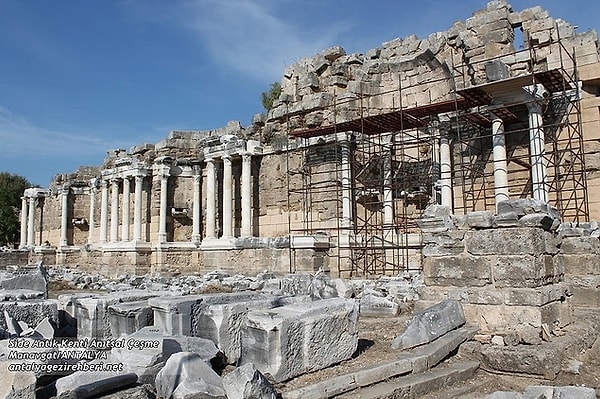
The Monumental Fountain, located in front of the entrance gate of the ancient city of Side, is dated to the 2nd century AD as a Roman creation. Recognised as the largest and most magnificent fountain in Anatolia and the Pamphylia region, the Monumental Fountain endures the test of time and conditions even to this day.
Architecture of the Monumental Fountain
It has three wide arches with half-round domes carved into the walls, twenty-one columns, three floors, and a pool in front. The Monumental Fountain was designed with marble-covered surfaces, embossed columns with fish and medusa heads, grooves between the columns, ceiling plates, relief dolphin fish patterns, and acanthus (bear's paw) leaf decoration. Only one floor of the monumental fountain has survived to the present day. Some of the ornaments and sculptures of the building are exhibited in the Side Museum. The historical fountain, also known as “9 Fountains”, came to life with the waters carried by the Manavgat Aqueducts, one of the most important natural building blocks of the place where it is located.
Source: Antalyagezirehberi.net
Side Museum

Side Museum is a restored historical building located at the entrance of Side. Side Museum, located in the historical building known as the old neighbourhood in Side Neighbourhood of Manavgat district of Antalya province, is one of the most important museums of our country today, as well as being the first museum established in our country. After the famous Monumental Fountain that welcomes you when you first arrive at the ruins of the ancient city of Side, the main city gate and the Collonaded Street will take you to the Side Museum on the right side of the road.
History of the Side Museum
A part of the Agora Municipal Baths complex, one of the architectural pieces identical to the spirit of the period, built during the Roman period in the ancient city of Side in the 2nd century AD, was restored and turned into a museum. In 1962, the present Side Museum was established. The old bath, which was built in the form of a rectangle consisting of five main sections in the past, was restored to our cultural area by covering three sections and arranging the other two sections as an open-air exhibition hall. These restoration works were carried out by the High Architect couple, Selma-Ragip Devrez.
About the Side Museum
In the Side Museum, where artefacts from the Late Hittite, Hellenistic, Roman, Seljuk and Islamic periods are exhibited, the majority of the works are exhibited in indoor halls, open areas and gardens. It includes the finds and artefacts unearthed during the excavations carried out by Prof. Dr. Arif Müfid Mansel and his team in Side between 1947-1967. Mansel is also the founder of the Side Museum. Most of the artifacts exhibited in the museum are the finds unearthed by Prof. Arif Müfid Mansel during his excavations in the ancient city of Side between 1947-1967: Hellenistic, Roman and Byzantine Periods; inscriptions, reliefs of weapons, sculptures, sarcophagi, ostoteks, amphorae, portraits, altars, tomb steles, torsos, column capitals and column bases that are copies of Greek originals made in the Roman Period.
Source: Kültür Portalı
Keşfet ile ziyaret ettiğin tüm kategorileri tek akışta gör!

Send Comment